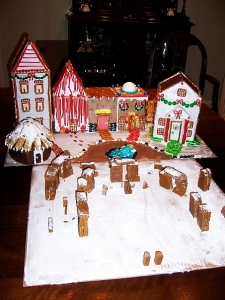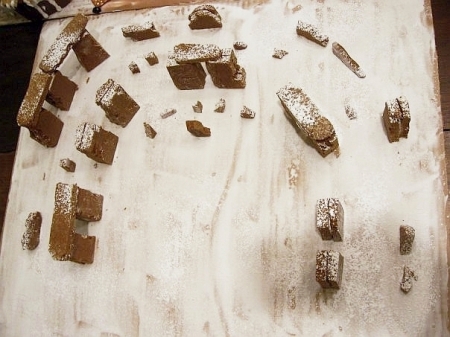photo sent in by Emily Hunziker, used with permission
And here is the second in our two part Hunziker series of henges! Yes, we know it’s Spring Equinox-ish/Easter/Eostre, and we’ll address that in our next post, but for now let us cast our minds back to three months and a week ago . . .
Ms. Hunziker writes: “The gingerbread henge came about this christmas time, when, for purposes of saving time, my family and our friend decided to combine our ginger bread house and winter solstice henge projects into one. We modeled our henge strictly off of stonehenge, making sure that there was even an alter stone and heel stone.”
You can see care was taken and Stonehenge was the model. Look at those bluestones, so rarely included in an amateur henge!
 Then, “We connected our christmasy gingerbread village with this henge by having the the Druids live in a hut right next door.” That hut is the little roundhouse in the picture on the left. Well done, we must say!
Then, “We connected our christmasy gingerbread village with this henge by having the the Druids live in a hut right next door.” That hut is the little roundhouse in the picture on the left. Well done, we must say!
And she finishes with, “Our friends and neighbors who come by appreciate the time and creativity we put into our projects but as we explain to them the ideas behind them (such as dolls made specifically to preform a “virgin sacrifice” that goes along with a henge made out of fish sticks or gingerbread) they smile, nod their heads, and back away slowly making no sudden movements.”
Well, that’s just a wise way to behave around hengers. Don’t trigger their chase response!
Score: 7 druids! They even have a place to live. We like this little set-up even if it is oddly horseshoe shaped over all. Having it open toward the viewer gives it a welcoming feel, not quite what the original Stonehenge builders were going for, but charming in its own right.
And at the end of the email she says, “lol. What can we say, we love it. Happy Henging!” We couldn’t have put it better ourselves.
Our thanks to Emily, Lauren, Russ and Eliza Hunziker and Lois Sisco for making this henge! Keep ’em coming!


 photo from Emily Hunzicker, used with permission
photo from Emily Hunzicker, used with permission




 our own photos
our own photos

 from a photo by Les Williams, used with permission
from a photo by Les Williams, used with permission



